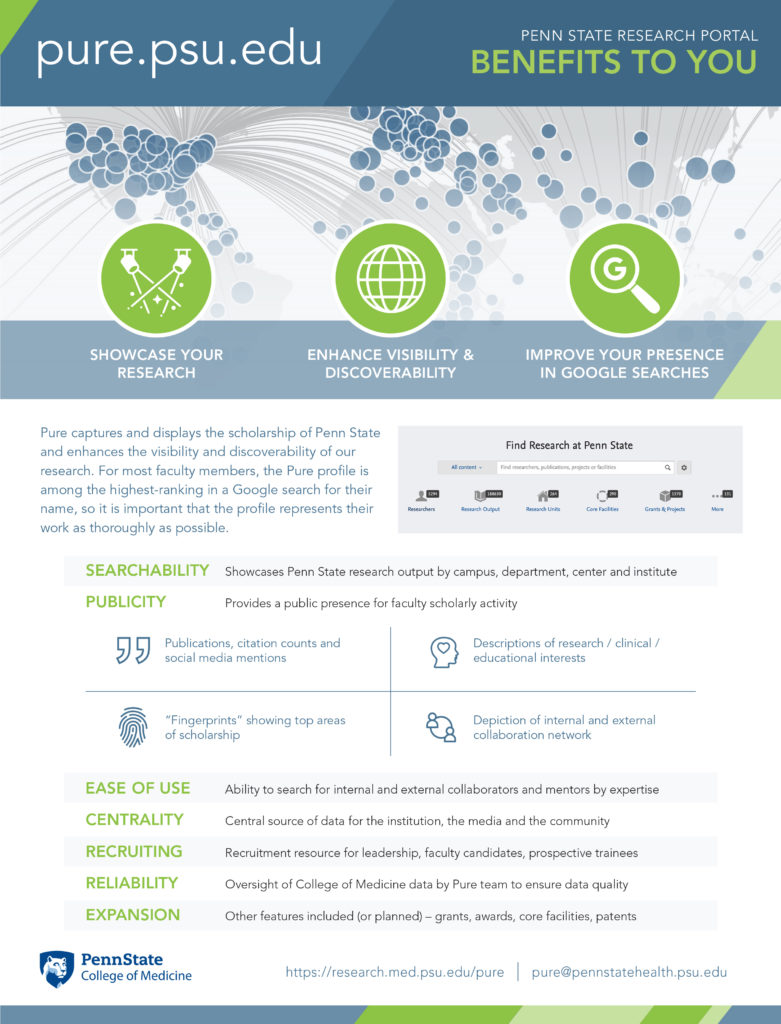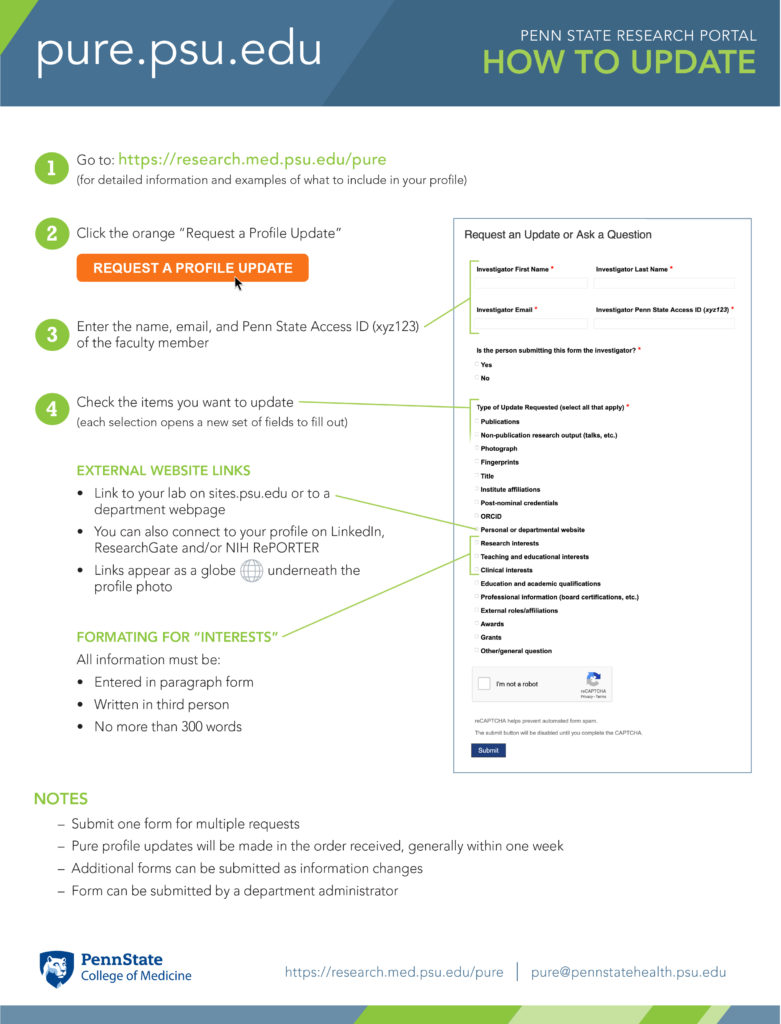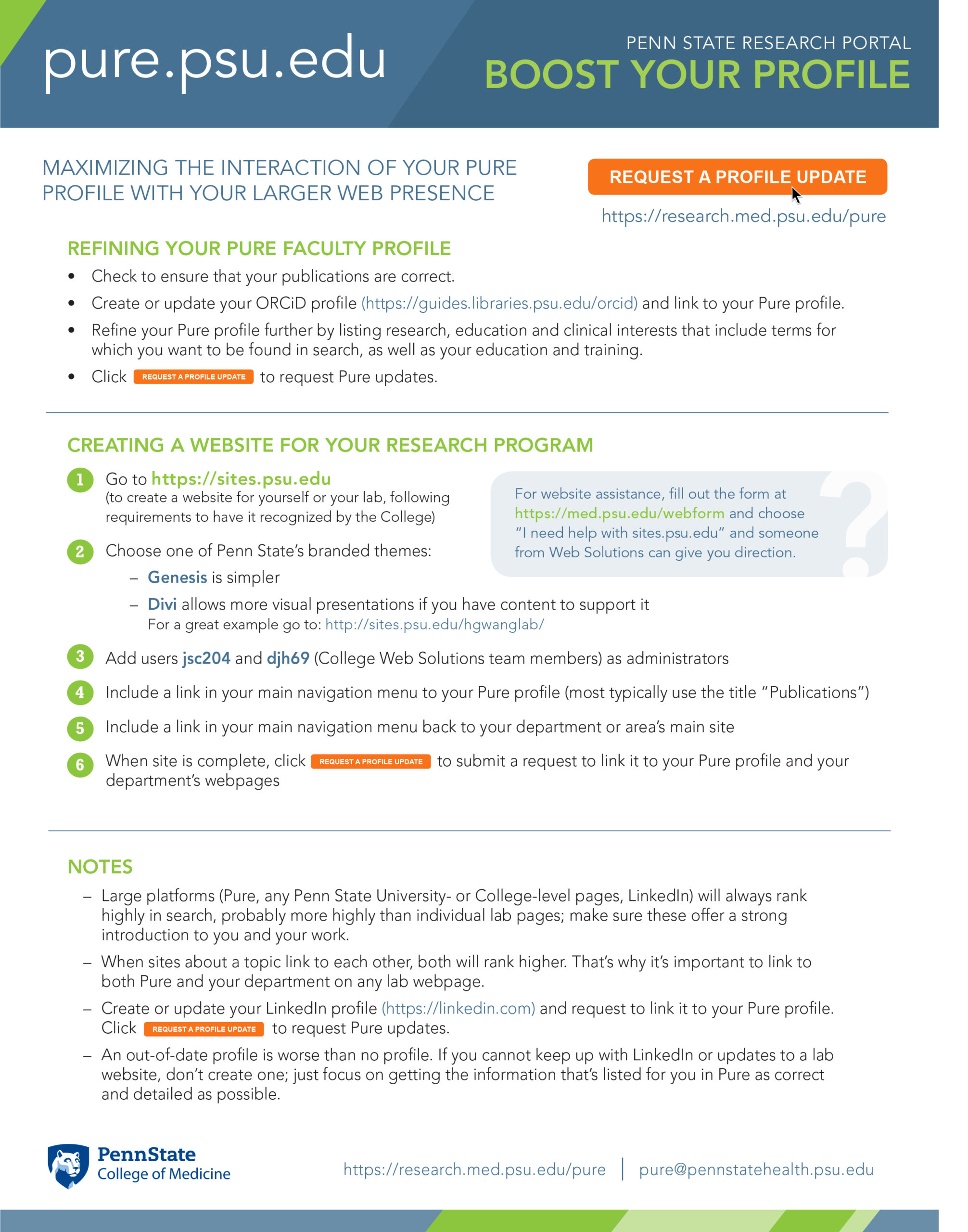Pure is the name of an application by the company Elsevier that stores and allows retrieval of information on investigators, research units and research output (such as publications). Penn State Research Portal is the University’s implementation of Pure.
The system captures and displays the research output of the University, both for investigators and units. Research information is aggregated from internal and external sources. The Pure portal is fully accessible to the public, and enhances the visibility and discoverability of research at Penn State, both internally and externally.
View and Search Pure Request a Profile Update Email the Pure team
Jump to topic
Search
Spread the Word about Pure
The Pure team has worked to create several flyers promoting Pure that can be printed and hung in work areas. Click each image to open the file in Sharepoint (Penn State Access ID login required), where it can be printed.
Updating Your Pure Profile
The College of Medicine Pure team will correct errors or make updates to individual profiles. Updates can be submitted by an investigator or anyone they designate.
You can explore specific areas that can be updated, along with examples of profiles containing that type of information, elsewhere in this guide.
To assist you in best curating your Pure profile, we have gathered examples from across the College of Medicine and Penn State Health showcasing some of the information that can be added to Pure. Browsing these profiles before submitting updates may help you refine your submission.
- Alison Chetlen, DO (research interests, clinical interests, teaching and educational interests, professional information, external positions, prizes, institute affiliation, clinical website link, ORCiD)
- Angela Choe, MD (research interests, teaching and educational interests, education and academic qualifications)
- Julio Fernandez-Mendoza, PhD, CBSM (research interests, professional information, education and academic qualifications)
- Jennifer Kraschnewski, MD, MPH (research interests, education and academic qualifications, external positions, institute affiliation)
- Nicole Osevala, MD (clinical interests, education and academic qualifications, Find a Provider profile link)
- Hong-Gang Wang, PhD (personal website link, research interests, education and academic qualifications)
Additions or deletions to publications/scholarly output can be made on an individual basis. To add or remove a publication, you must provide the full citation.
Note regarding additions: Before making an addition request, you must first verify that the publication in question is not already in your Pure profile, and you must list each unlisted publication individually. We cannot accept lists of publications from other websites to compare with Pure, and we do need full citations in order to make an addition.
Research output that typically doesn’t appear in a database, such as a presentation at a national meeting, a TED Talk, prize or award (non-grant), etc., can be added.
This section is currently limited to five entries; if you already have five, you must submit a request to remove one when requesting an addition.
Please provide as much information about the output as relevant, including title, date, name of conference, etc.
Photographs in Pure are pulled from the official College of Medicine/Penn State Health photo bank. We use the most recent photo in the system, but can only post photos taken in the past four years.
If you do not like your photo, have only an older photo, or have not had a photo taken on campus, please submit a photo request form through Workfront and someone from Photography will arrange a date and time for you to have a new photo taken. If you do not have Workfront access, see instructions on having an account created here.
When requesting a photo update to your Pure profile, you do not submit the photo, only the date it was taken.
Alternately, if you are a medical provider with a profile in Find a Provider, we can extract your photo from that system.
Fingerprint terms can be removed from your profile if you don’t wish to be findable in a search for that particular term (e.g., older research). New fingerprints cannot be added.
Faculty ranks will be updated by the Pure team each August, based on information from the Dean’s Office.
Currently, only certain other preferred titles are included – deans, chairs and endowed professorships. These are also updated based on data from the Dean’s Office and University. You may contact the team if you feel such a title is missing or incorrect.
Affiliations with or membership in any of the six institutes overseen by the College of Medicine can be added to your Pure profile.
Institutes that can be added are:
- Penn State Cancer Institute (please include whether member or affiliate, and, if a member, the research project
- Penn State Clinical and Translational Science Institute
- Penn State Neuroscience Institute
- Penn State Institute for Personalized Medicine
- Penn State Heart and Vascular Institute
- Penn State Bone and Joint Institute
Request an Institute Affiliation Update See example of Institute Affiliations
Our listing of degrees is derived from the College’s Integrated Faculty List. If your degree credentials are inaccurate, you may contact the Pure team.
Your ORCiD can be tied to your Pure profile. If yours is not displaying in Pure, you can submit an update to have it added.
You may also wish to link your ORCiD identifier to your Penn State login for ease of management.
To reflect any department, division, institute, center, multi-investigator project or clinical research of any kind, investigators must submit a request to the College of Medicine’s Marketing & Communications web team via Workfront request forms. This information must be part of the institution’s centrally managed website infrastructure per policy A-95 HAM (Penn State Health ePass login required).
In selected cases, individual investigators who wish to maintain a personal website for their laboratory may be granted permission to do so using the institutional sites.psu.edu platform, provided certain guidelines are followed. An individual investigator must first contact the marketing web team to verify approval.
For individual-investigator sites to be approved, they must follow these guidelines:
- Individual websites must be created using the sites.psu.edu platform.
- Sites must use one of the Penn State themes provided without design modifications.
- Genesis is simpler
- Divi allows more visual presentations for investigator with the content to support that treatment
- Note: As of September 2022, the Genesis theme has been retired by the university and is only available on sites that already have it activated. New sites will need to use Divi.
- The site must include a link to the PI’s department’s central academic web presence in the top navigation menu.
- A “Publications” link in the top navigation menu must link directly to the PI’s Pure profile.
- Job postings, including postdoctoral positions, must link to the appropriate HR posting for submission of applications.
- A user from the College of Medicine’s marketing web team – mje151 – must be added as administrator.
Alternatively, Pure profiles may include links to any of the following:
- The investigator’s department or institute’s central web presence
- A Web Solutions-created page or section for a particular research group of which the investigator is part
- Find a Provider profile, if applicable
- LinkedIn profile
- ResearchGate profile
- NIH RePORTER profile
Please note that other sites – including Google Scholar profiles, personal websites and profiles on other institutions’ sites – are not permitted for linking.
 All approved links appear as a globe underneath the profile photo, like the one pictured here.
All approved links appear as a globe underneath the profile photo, like the one pictured here.
Profiles in Pure can include a paragraph describing your research. This is a good place to include key words for which you wish to be found.
Research interests are limited to 300 words and must be written in third person. Do not repeat titles or institute affiliations in the research interest narrative.
Submit a Research Interest Narrative See example of research interests
Profiles in Pure can include a summary of your teaching and educational interests.
This section is limited to 300 words and must be written in third person.
Submit Teaching and Educational Interests See example of educational interests
Clinical interests (if applicable) can also be feature in a Pure profile.
This section is limited to 300 words and must be written in third person.
Submit a Clinical Interest Narrative
Please note: This will update your clinical interests in Pure only. To submit an update to your Provider Profile at hmc.pennstatehealth.org, visit hmc.pennstatehealth.org/provider-update.
You may include undergraduate, graduate and post-degree institutions (including postdocs, residencies, fellowships, etc.) and certain certifications. Please provide the start and end years, the specialty (if applicable) and the type of training.
Update Education and Academic Qualifications See example of education
Professional designations, such as board certification and licensure, can be added to your Pure profile. There is currently a limit of five such designations.
Submit Professional Information See example of professional information
Your Pure profile can showcase up to five external roles or affiliations. This can include leadership or membership in a scientific or advocacy organization, serving on a board or as a conference organizer, chairing an editorial board, etc.
Update External Roles/Affiliations See example of external roles
You can include awards received from external organizations or within Penn State. There is a limit of eight awards per person. These should not include grant-funding awards, but rather prizes and honors.
We are currently only able to display certain grants and projects. The system is linked to a number of major funders and we can pull grant information from these. Please submit a request for missing grants and we will determine if they are included in one of our sources. As always, the information available is not guaranteed to be correct and you are encouraged to review the content of your profile periodically.
The Pure team is always willing to provide more information on how to update your profile. Simply choose “Other/general question” in the update form and let us know how we can help.
Learn More About Pure

The Pure system is comprised of profiles of faculty from across all Penn State campuses. The total number of profiles is determined by the contract in place at any given time. The number of faculty by campus will vary.
Search for Collaborators by Topic
Enter a keyword into the Pure search box to see researchers, research outputs or research units affiliated with that topic.
Analyze a Block of Text and Find Researchers
If you have a block of text, such as an abstract or concept paper (or a funding announcement), and want to find potential collaborators, Pure offers the ability to search based on that text.
Click the gear icon next to the search box and choose “Copy/paste text – find expertise.”
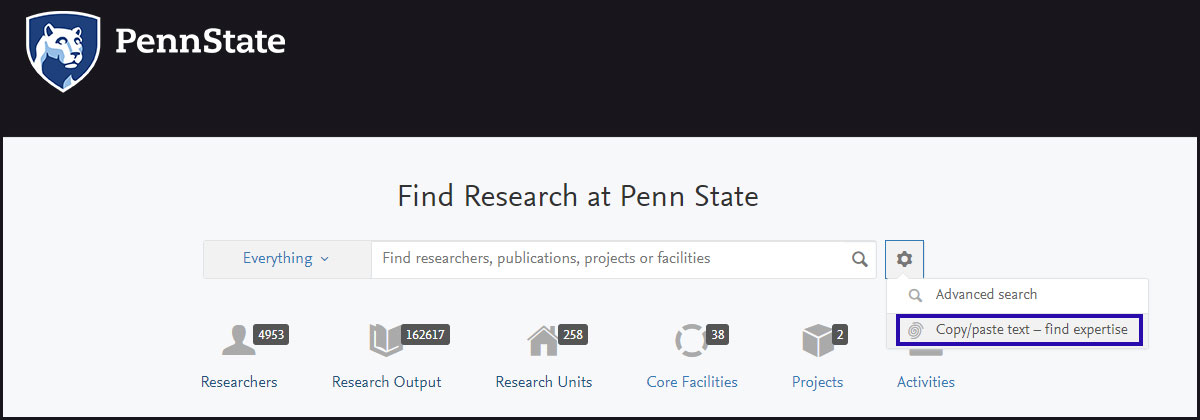
See Research Output and Metrics
Within Pure, you can see a researcher’s recent publications, and view article metrics such as citations, news mentions or social media references.
Simply search for the researcher’s name (full or last), select the appropriate profile, and choose “Research Output.”
Search for External Collaborators
You can also search for researchers at non-Penn State institutions who use the Pure tool.
From the main screen, choose “Researchers.” In the search box on this page, enter a topic, then click the option at right to “Include results from Experts Community.”
You will see a list of other researchers in Pure with work on that topic.
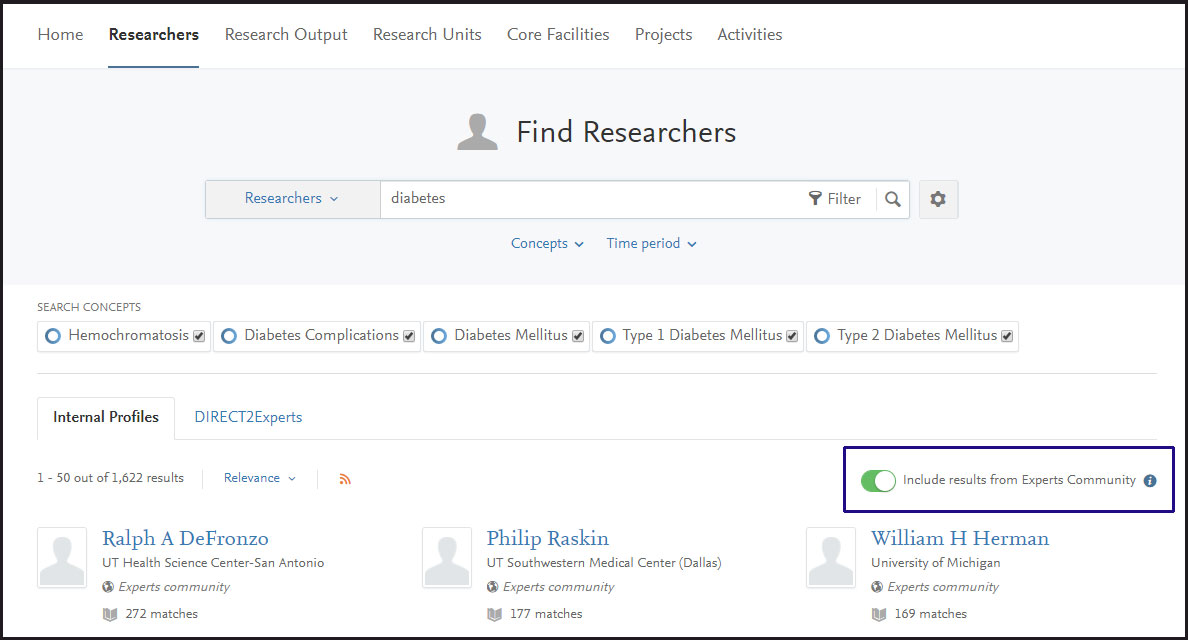
Names, current rank, some titles, contact information and primary department are populated from Penn State records and other internal sources.
Research output and citation counts are captured from Scopus (Elsevier).
“Fingerprints,” or key topics, are associated with each profile, generated by Elsevier based on a researcher’s output.
Social media mentions are noted through PlumX and Altmetric.
Grants and projects are imported through Pure’s own funding database, which includes a number of funders such as NIH.
Social media analytics (PlumX and Altmetric) are updated daily.
Publications are updated weekly (once a profile is established).
Citation data are updated monthly.
Data from Penn State is updated on a semi-annual basis.
Pure includes feeds from Scopus (Elsevier) as well as manual entry of scholarly output and activities not captured by Scopus. While efforts are made by Elsevier and the College of Medicine Pure team to account for accuracy in the data, it is possible to have missing publications as well as publications not authored by a faculty member in question.
Available publication and citation data are limited by the indexing policies of Elsevier at the time of publication. Citation data will likely vary from Web of Science or Google Scholar statistics. Manual entries of publications will not contain citation counts in Pure.
Contact the College of Medicine’s Pure team with specific data questions.
Google Scholar is an open-access way of distributing information about scholarship.
However, the absence of quality control in this tool is an issue. Sometimes a publication will show up in Google Scholar more than once, in subtly different ways, and this seems to be more true with a highly cited publications. This can amplify the citation count seen in Google Scholar to be much higher than what you will see through Pure, which uses the Scopus-based H-index.
The Scopus-generated H-index is more reliable, and will generally be lower for every investigator than their Google Scholar H-index.
Advantages of Google Scholar
- Coverage/content and citation counts are broader than those covered by Scopus or Web of Science.
Disadvantages of Google Scholar
- Not every faculty member at Penn State has a profile.
- Search ability is limited.
- Bulk data downloads are not permitted.
- Grouping is not possible (seeing all publications for a department, for instance).
- Information can not be reused.
- Quality control and indexing are lacking (for example, no tagging of top keywords for an investigator).
- Any academic-domain document is indexed and can emit and receive citations.
Sources
Halevi, Gali (2017). Suitability of Google Scholar as a source of scientific information and as a source of data for scientific evaluation — Review of the Literature. Journal of informetrics (1751-1577), 11 (3), p. 823.
Delgado Lopez-Cozar, Emilio; Robinson-Garcia, Nicolas; Torres Salinas, Daniel (2012). Manipulating Google Scholar Citations and Google Scholar Metrics: simple, easy and tempting. EC3 Working Papers 6: 29 May, 2012
The Pure portal is maintained by the Penn State Office of the Senior Vice President for Research.
An advisory board comprising multiple groups and units across Penn State assists with decisions regarding Pure strategy and oversight.
The College of Medicine has a team who oversees College data in the system.

